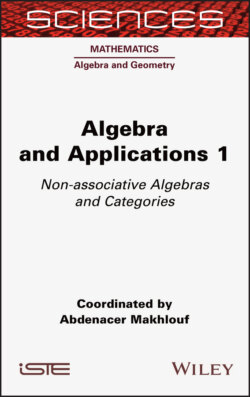Читать книгу Algebra and Applications 1 - Abdenacer Makhlouf - Страница 23
1.8. Jordan superconformal algebras
ОглавлениеIn this section, we will discuss connections between infinite dimensional Jordan superalgebras and the so-called superconformal algebras that originated in mathematical physics.
In view of importance of the Virasoro algebra and (especially) its central extensions in physics, (Neveu and Schwarz 1971; Ramond 1971) and others considered superextensions of the algebra Vir. These superextensions became known as superconformal algebras. Kac and van de Leur (1989) put the theory on a more formal footing and recognized that all known superconformal algebras are in fact infinite dimensional superalgebras of Cartan type considered in Kac (1977b). Following (Kac and van de Leur 1989), we call a ℤ-graded Lie superalgebra a superconformal algebra if
1 i) L is graded simple;
2 ii) ;
3 iii) the dimensions dim Li, i ∈ ℤ are uniformly bounded.
EXAMPLE 1.31.– The Lie superalgebra of superderivations
graded by degrees of t is a superconformal algebra.
EXAMPLE 1.32.– Let α ∈ ℂ. Then S(n, α) = {D ∈ W (1 : n) | div(tαD) = 0} < W (1 : n). Here if
then
If α ∈ ℤ, then [S(n, α), S(n, α)] is a proper ideal in S(n, α) and the superalgebra [S(n, α), S(n, α)] is simple. This family of superalgebras appeared in physics literature (Ademollo et al. 1976; Schwimmer and Seiberg 1987) under the name “SU2-superconformal algebras”.
EXAMPLE 1.33.– Consider the associative commutative superalgebra
and the contact bracket [ , ] of example 1.19. The superalgebra K(n) = (Λ(1 : n), [ , ]) is simple unless n = 4. For n = 4, the commutator ideal [K(4), K(4)] has codimension 1 and [K(4), K(4)] is a simple superalgebra. This series is known in physics literature as “SOn-superconformal algebras” (Ademollo et al. 1976; Schoutens 1987).
EXAMPLE 1.34.– In section 1.5, for an arbitrary associative commutative algebra Z with a derivation d : Z → Z, we constructed the Jordan superalgebra JCK(Z, d). The Lie superalgebra CK(Z, d) is the Tits–Kantor–Koecher construction of JCK (Z, d). Taking Z = ℂ[t, t–1] and or , we get the Cheng–Kac superalgebras CK(6) discovered by Cheng and Kac (1997) and independently by Grozman et al. (2001).
Kac and van de Leur (1989) conjectured that examples 1.31–1.34 exhaust all superconformal algebras.
The superalgebras K(n) and CK(6) appear as Tits–Kantor–Koecher constructions of Jordan superalgebras.
Let [ , ] be the Jordan bracket on Λ(1 : n) = ℂ [t, t–1, ξ1,…, ξn] of example 1.20, Jn = K(Λ(1 : n), [ , ]) is the Kantor double of this bracket. Then
In Kac et al. (2001), we classified “superconformal” Jordan superalgebras.
THEOREM 1.11 (Kac et al. (2001)).– Let be a ℤ-graded Jordan superalgebra that is graded simple and the dimensions of all homogeneous components dim Ji, i ∈ ℤ are uniformly bounded. Then either
1 1) J has finitely many negative (respectively, positive) non-zero homogeneous components;
2 2) or J is isomorphic to one of the superalgebras Jn, JCK(6), n ≥ 1 or a twisted version of it.
This theorem agrees with the Kac–van de Leur conjecture on classification of superconformal algebras.
